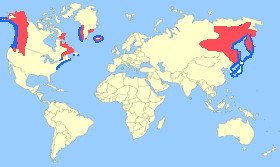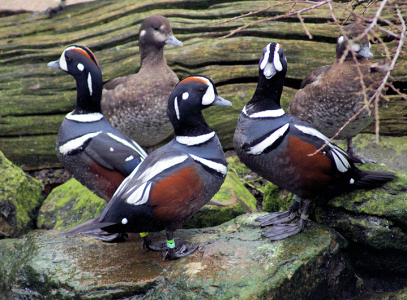Appearance:
Male - The male Harlequin Duck has a dark bluish-grey head and neck with a large white crescent patch between the eye and the blue-grey beak which extends over the crown and down the nape turning chestnut colour, along with a black band from the beak running over the crown and down the nape, white spot on the ear-coverts and white patch on sides of neck, the chin, throat and front neck are black, upperback and breast are grey, the flanks have large chestnut patches, a brownish-grey abdomen, white patches on body are bordered with black, and grey legs and feet.
Female - The female is sooty-brown with whitish patches on head.
Eclipse - The male in eclipse is similar to the female but retains white markings on the head, breast, and wings.
Size: - Typical Adult is 35-40cm (14-16in).
Food: - Crustaceans, Molluscs, insects, and larvae.
Habitat/Range: - Fast moving streams, and coastal waters. The Eastern Harlequin is resident in Greenland, and Iceland, and the Pacific Harlequin is found in eastern Siberia, and North America. North American Harlequin winter further south along the coast of Maine.

 Breeding Habitat/Resident,
Breeding Habitat/Resident,  Migration or Winter Area.
Migration or Winter Area.Breeding Season: - Late May in Iceland, and late June in Arctic regions.
Eggs: - 5 to 6 (creamy-yellow colour).
Notes: - The Harlequin Duck is a small sea duck. It gets its name because of a colourfully dressed character in Commedia dell'arte.
Conservation status (IUCN 3.1):
Least Concern.
Classification: - Family: Anatidae,
Subfamily: Merginae, Genus: Histrionicus.



 photo by Neill Smith.
photo by Neill Smith.
